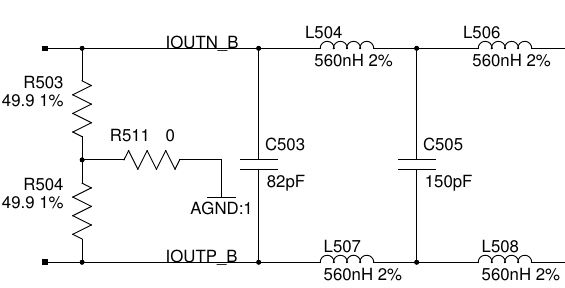I think I should expand on what Fake Mustache said about low frequency / DC design for DACs:
You do not generally prefer the opamp output stage. This gets increasingly important with the bandwidth of the signal you want to generate.
For example, see the schematic (p.1) of this high-rate DAC'ing software defined radio peripheral.
The idea behind these devices is that the DAC sits on the motherboard, and you use interchangeable daughterboards to take the generated signal, and filter it, mix it up to some RF, amplify etc it. That means the signal has to travel a bit and cross a connector before it reaches the relevant analog circuitry. Here, the design choice was hence to use a current DAC.
The AD9777 DAC's analog outputs get directly fed into the daughterboard connector:


Then, on the daughterboard (let's talk about the WBX here, schematic):

we see that
- we match the 50 Ohm of the transmission line, which is necessary to get the most energy out of the DAC into our daughterboard (and corollary, the least reflections/distortions and
- no active parts whatsoever involved in buffering what the DAC produces.
So, the DAC here runs at 100MS/s, which means that it's already wise to not think of the signal as "current flowing through a piece of metal", but to layout the differential lines from DAC to connector as microwave lines, i.e. microstrip etc, and commit to the fact that the fields around these conductors will carry the energy. In this scenario, capable opamps are hard to find, harder to get linear and even harder to get linear enough not to waste expensive DAC bits.
Of course, a DAC for these rates is specced with an output impedance that allows for correct transmission line impedance and termination impedance design. Which also means that for the 50 Ohm termination used here, Analog guarantees driving capabilities. From the AD9777 datasheet, p. 46:
Note that the output impedance of the AD9777 DAC itself is
greater than 100 kΩ and typically has no effect on the
impedance of the equivalent output circuit.
hence, we're pretty much in the case where "ok, you've got a sink impedance in the range of 100Ω, but the source impedance is much much higher, so don't you worry". Of course, p. 47 also explains how you can use an Opamp as output buffer:

Yet the text mentions explicitly the disadvantages and design restrictions this has:
The common-mode (and second-order distortion) rejection of
this configuration is typically determined by the resistor
matching. The op amp used must operate from a dual supply
since its output is approximately ±1.0 V. A high speed amplifier,
such as the AD8021, capable of preserving the differential
performance of the AD9777 while meeting other system level
objectives (for example, cost, power) is recommended.
Since Opamps are never perfect, you infer a lot of additional problems. Just think about parasitic capacitance in the feedback line, inclucing the 500 Ohm resistor, or the fact that resistors and package pins have inductance, that change the phase of a signal depending on the signal's frequency... suddenly, your broadband DAC has a less-than-flat buffer, and changing that might not be trivial, lest you reduce the bandwidth to something manageable.






